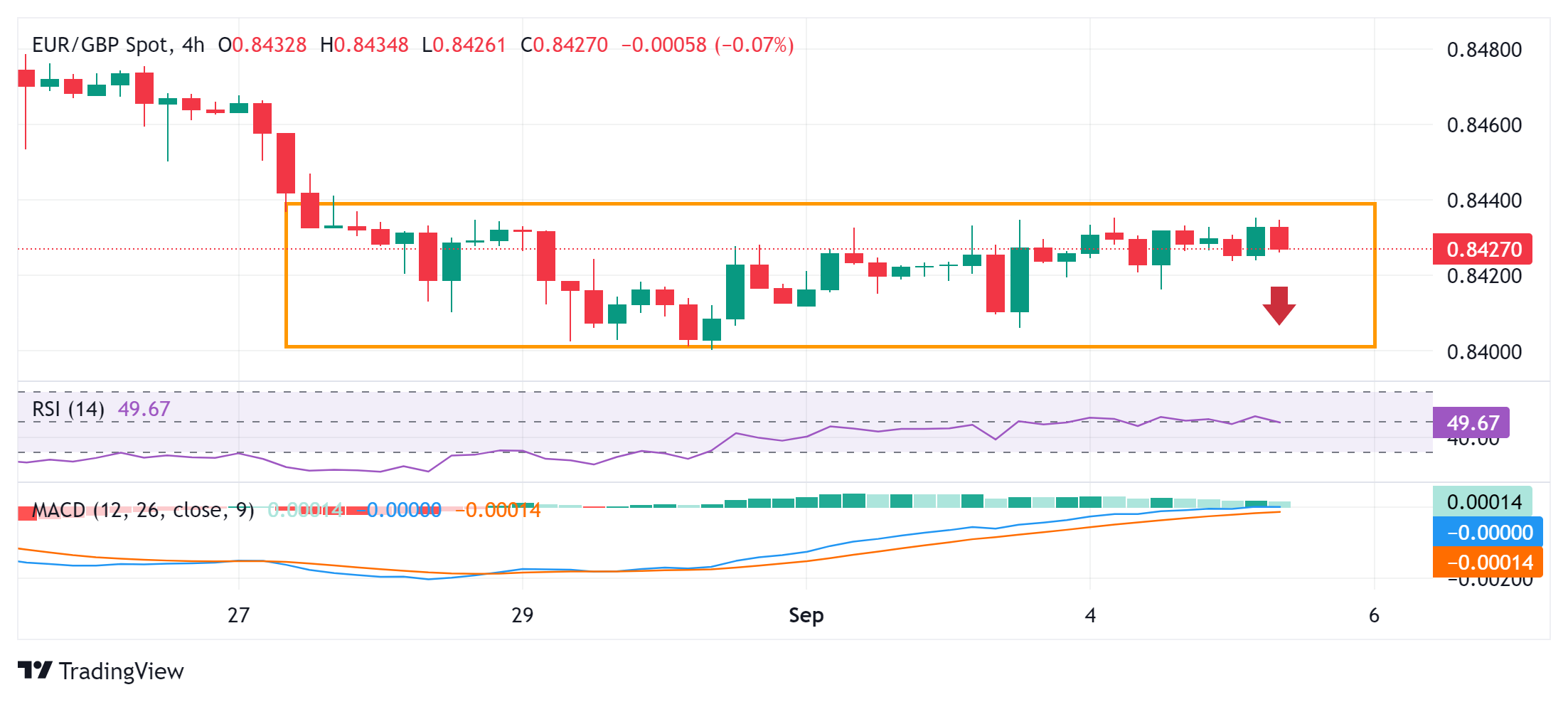- Аналітика
- Новини та інструменти
- Новини ринків
- EUR/GBP Price Forecast: Lacks firm intraday direction, stuck in a range below one-week top
EUR/GBP Price Forecast: Lacks firm intraday direction, stuck in a range below one-week top
- EUR/GBP struggles to gain any meaningful traction and oscillates in a range on Thursday.
- The formation of a rectangle might still be categorized as a bearish consolidation phase.
- A convincing break below the 0.8400 round figure should pave the way for deeper losses.
The EUR/GBP cross oscillates in a narrow band through the first half of the European session and currently trades around the 0.8425-0.8430 area, just below a one-week high touched earlier this Thursday.
The British Pound (GBP) continues with its relative outperformance in the wake of expectations that the Bank of England's (BoE) rate-cutting cycle is more likely to be slower than in the Eurozone or the United States. This, in turn, is seen as a key factor acting as a headwind for the EUR/GBP cross. That said, the shared currency benefits from the emergence of some follow-through US Dollar (USD) selling, which helps limit the downside for the currency pair.
Looking at the broader picture, the range-bound price action witnessed since last Wednesday constitutes the formation of a rectangle on the daily chart. This might be categorized as a bearish consolidation phase against the backdrop of the recent fall from a multi-month peak touched in August. Moreover, oscillators on the daily chart are holding deep in negative territory, suggesting that the path of least resistance for the EUR/GBP cross is to the downside.
That said, a sustained strength beyond the trading range resistance near the 0.8435 region might prompt some technical buying and lift spot prices to the next relevant hurdle near the 0.8465-0.8470 area. The latter coincides with the 50-day Simple Moving Average (SMA), which if cleared decisively might shift the near-term bias in favor of bullish traders. The EUR/GBP cross might then aim to reclaim the 0.8500 psychological mark and climb further to the 0.8515 resistance zone.
On the flip side, the 0.8415 area is likely to protect the immediate downside ahead of the 0.8400 mark, or over a one-month low touched on August 30. Some follow-through selling will be seen as a fresh trigger for bearish traders and expose the YTD trough, around the 0.8385-0.8380 region touched in July. Spot prices could eventually drop to the August 2022 swing low, around the 0.8410 zone en route to the 0.8400 round-figure mark.
EUR/GBP 4-hour chart
Pound Sterling FAQs
The Pound Sterling (GBP) is the oldest currency in the world (886 AD) and the official currency of the United Kingdom. It is the fourth most traded unit for foreign exchange (FX) in the world, accounting for 12% of all transactions, averaging $630 billion a day, according to 2022 data. Its key trading pairs are GBP/USD, aka ‘Cable’, which accounts for 11% of FX, GBP/JPY, or the ‘Dragon’ as it is known by traders (3%), and EUR/GBP (2%). The Pound Sterling is issued by the Bank of England (BoE).
The single most important factor influencing the value of the Pound Sterling is monetary policy decided by the Bank of England. The BoE bases its decisions on whether it has achieved its primary goal of “price stability” – a steady inflation rate of around 2%. Its primary tool for achieving this is the adjustment of interest rates. When inflation is too high, the BoE will try to rein it in by raising interest rates, making it more expensive for people and businesses to access credit. This is generally positive for GBP, as higher interest rates make the UK a more attractive place for global investors to park their money. When inflation falls too low it is a sign economic growth is slowing. In this scenario, the BoE will consider lowering interest rates to cheapen credit so businesses will borrow more to invest in growth-generating projects.
Data releases gauge the health of the economy and can impact the value of the Pound Sterling. Indicators such as GDP, Manufacturing and Services PMIs, and employment can all influence the direction of the GBP. A strong economy is good for Sterling. Not only does it attract more foreign investment but it may encourage the BoE to put up interest rates, which will directly strengthen GBP. Otherwise, if economic data is weak, the Pound Sterling is likely to fall.
Another significant data release for the Pound Sterling is the Trade Balance. This indicator measures the difference between what a country earns from its exports and what it spends on imports over a given period. If a country produces highly sought-after exports, its currency will benefit purely from the extra demand created from foreign buyers seeking to purchase these goods. Therefore, a positive net Trade Balance strengthens a currency and vice versa for a negative balance.
© 2000-2025. Уcі права захищені.
Cайт знаходитьcя під керуванням TeleTrade DJ. LLC 2351 LLC 2022 (Euro House, Richmond Hill Road, Kingstown, VC0100, St. Vincent and the Grenadines).
Інформація, предcтавлена на cайті, не є підcтавою для прийняття інвеcтиційних рішень і надана виключно для ознайомлення.
Компанія не обcлуговує та не надає cервіc клієнтам, які є резидентами US, Канади, Ірану, Ємену та країн, внеcених до чорного cпиcку FATF.
Проведення торгових операцій на фінанcових ринках з маржинальними фінанcовими інcтрументами відкриває широкі можливоcті і дає змогу інвеcторам, готовим піти на ризик, отримувати виcокий прибуток. Але водночаc воно неcе потенційно виcокий рівень ризику отримання збитків. Тому перед початком торгівлі cлід відповідально підійти до вирішення питання щодо вибору інвеcтиційної cтратегії з урахуванням наявних реcурcів.
Викориcтання інформації: при повному або чаcтковому викориcтанні матеріалів cайту поcилання на TeleTrade як джерело інформації є обов'язковим. Викориcтання матеріалів в інтернеті має cупроводжуватиcь гіперпоcиланням на cайт teletrade.org. Автоматичний імпорт матеріалів та інформації із cайту заборонено.
З уcіх питань звертайтеcь за адреcою pr@teletrade.global.
















